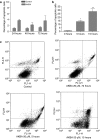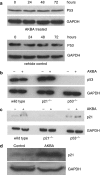Acetyl-keto-beta-boswellic acid inhibits cellular proliferation through a p21-dependent pathway in colon cancer cells
- PMID: 16783403
- PMCID: PMC1752013
- DOI: 10.1038/sj.bjp.0706817
Acetyl-keto-beta-boswellic acid inhibits cellular proliferation through a p21-dependent pathway in colon cancer cells
Abstract
1. Although there is increasing evidence showing that boswellic acid might be a potential anticancer agent, the mechanisms involved in its action are unclear. 2. In the present study, we showed that acetyl-keto-beta-boswellic acid (AKBA) inhibited cellular growth in several colon cancer cell lines. Cell cycle analysis by flow cytometry showed that cells were arrested at the G1 phase after AKBA treatment. 3. Further analysis showed that cyclin D1 and E, CDK 2 and 4 and phosphorylated Rb were decreased in AKBA-treated cells while p21 expression was increased. 4. The growth inhibitory effect of AKBA was dependent on p21 but not p53. HCT-116 p53(-/-) cells were sensitized to the apoptotic effect of AKBA, suggesting that p21 may have protected cells against apoptosis by inducing a G1 arrest.5. In conclusion, we have demonstrated that AKBA inhibited cellular growth in colon cancer cells. These findings may have implications to the use of boswellic acids as potential anticancer agents in colon cancer.
Figures








Similar articles
-
3-O-acetyl-11-keto-β-boswellic acid exerts anti-tumor effects in glioblastoma by arresting cell cycle at G2/M phase.J Exp Clin Cancer Res. 2018 Jul 3;37(1):132. doi: 10.1186/s13046-018-0805-4. J Exp Clin Cancer Res. 2018. PMID: 29970196 Free PMC article.
-
LY294002 enhances boswellic acid-induced apoptosis in colon cancer cells.Anticancer Res. 2009 Aug;29(8):2987-91. Anticancer Res. 2009. PMID: 19661305
-
Acetyl-11-keto-β-boswellic acid (AKBA) inhibits human gastric carcinoma growth through modulation of the Wnt/β-catenin signaling pathway.Biochim Biophys Acta. 2013 Jun;1830(6):3604-15. doi: 10.1016/j.bbagen.2013.03.003. Epub 2013 Mar 14. Biochim Biophys Acta. 2013. Retraction in: Biochim Biophys Acta. 2015 Jan;1850(1):254. doi: 10.1016/j.bbagen.2014.11.003. PMID: 23500016 Retracted.
-
Acetyl-11-keto-beta-boswellic acid (AKBA) prevents human colonic adenocarcinoma growth through modulation of multiple signaling pathways.Biochim Biophys Acta. 2013 Oct;1830(10):4907-16. doi: 10.1016/j.bbagen.2013.06.039. Epub 2013 Jul 10. Biochim Biophys Acta. 2013. Retraction in: Biochim Biophys Acta. 2015 Jan;1850(1):253. doi: 10.1016/j.bbagen.2014.11.002. PMID: 23850473 Retracted.
-
Acetyl-11-keto-β-boswellic acid enhances the cisplatin sensitivity of non-small cell lung cancer cells through cell cycle arrest, apoptosis induction, and autophagy suppression via p21-dependent signaling pathway.Cell Biol Toxicol. 2021 Apr;37(2):209-228. doi: 10.1007/s10565-020-09541-5. Epub 2020 Jun 20. Cell Biol Toxicol. 2021. PMID: 32562082 Free PMC article.
Cited by
-
Comparative study of the cytotoxicity, apoptotic, and epigenetic effects of Boswellic acid derivatives on breast cancer.Sci Rep. 2022 Nov 21;12(1):19979. doi: 10.1038/s41598-022-24229-y. Sci Rep. 2022. PMID: 36411309 Free PMC article.
-
Boswellic acid suppresses growth and metastasis of human pancreatic tumors in an orthotopic nude mouse model through modulation of multiple targets.PLoS One. 2011;6(10):e26943. doi: 10.1371/journal.pone.0026943. Epub 2011 Oct 31. PLoS One. 2011. Retraction in: PLoS One. 2022 Sep 28;17(9):e0275582. doi: 10.1371/journal.pone.0275582. PMID: 22066019 Free PMC article. Retracted.
-
3-O-acetyl-11-keto-β-boswellic acid exerts anti-tumor effects in glioblastoma by arresting cell cycle at G2/M phase.J Exp Clin Cancer Res. 2018 Jul 3;37(1):132. doi: 10.1186/s13046-018-0805-4. J Exp Clin Cancer Res. 2018. PMID: 29970196 Free PMC article.
-
Acetyl-11-keto-β-boswellic acid inhibits proliferation and induces apoptosis of gastric cancer cells through the phosphatase and tensin homolog /Akt/ cyclooxygenase-2 signaling pathway.World J Gastroenterol. 2020 Oct 14;26(38):5822-5835. doi: 10.3748/wjg.v26.i38.5822. World J Gastroenterol. 2020. PMID: 33132637 Free PMC article.
-
Googling the Guggul (Commiphora and Boswellia) for Prevention of Chronic Diseases.Front Pharmacol. 2018 Aug 6;9:686. doi: 10.3389/fphar.2018.00686. eCollection 2018. Front Pharmacol. 2018. PMID: 30127736 Free PMC article. Review.
References
-
- CAPUTI M., RUSSO G., ESPOSITO V., MANCINI A., GIORDANO A. Role of cell-cycle regulators in lung cancer. J. Cell Physiol. 2005;205:319–327. - PubMed
-
- GARTEL A.L., RADHAKRISHNAN S.K. Lost in transcription: p21 repression, mechanisms, and consequences. Cancer Res. 2005;65:3980–3985. - PubMed
-
- GARTEL A.L., TYNER A.L. The role of the cyclin-dependent kinase inhibitor p21 in apoptosis. Mol. Cancer Ther. 2002;1:639–649. - PubMed
-
- GERHARDT H., SEIFERT F., BUVARI P., VOGELSANG H., REPGES R. Therapy of active Crohn disease with Boswellia serrata extract H 15] Z. Gastroenterol. 2001;39:11–17. - PubMed
Publication types
MeSH terms
Substances
LinkOut - more resources
Full Text Sources
Research Materials
Miscellaneous

